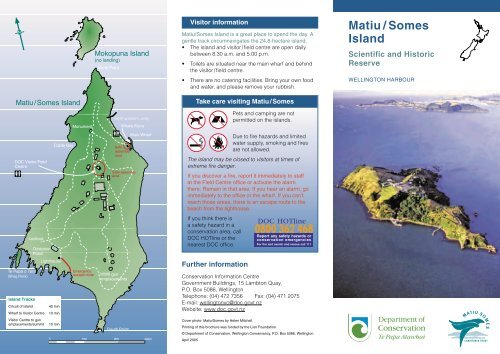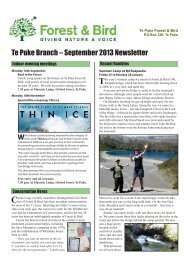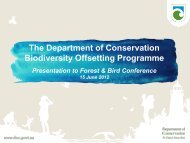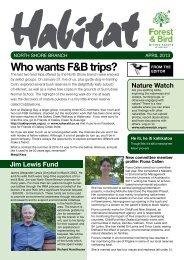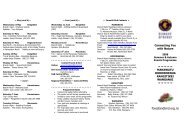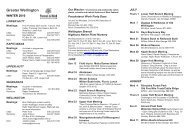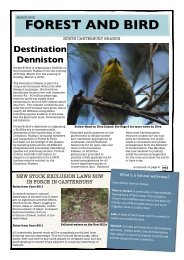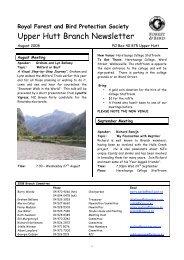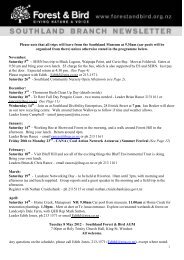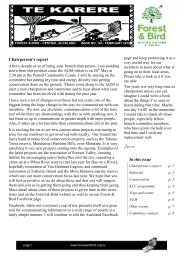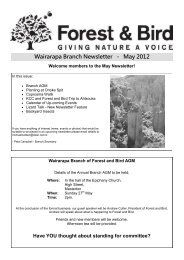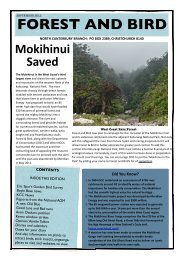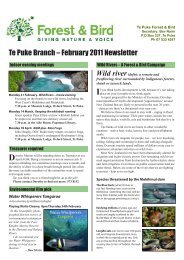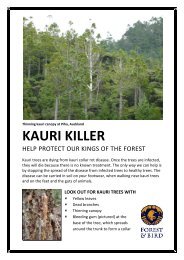Matiu / Somes Island - Forest and Bird
Matiu / Somes Island - Forest and Bird
Matiu / Somes Island - Forest and Bird
You also want an ePaper? Increase the reach of your titles
YUMPU automatically turns print PDFs into web optimized ePapers that Google loves.
<strong>Isl<strong>and</strong></strong> Tracks<br />
Circuit of isl<strong>and</strong> 45 min<br />
Wharf to Visitor Centre 10 min<br />
Visitor Centre to gun<br />
emplacements/summit 10 min<br />
Northwestern Jetty<br />
Visitor information<br />
<strong>Matiu</strong>/<strong>Somes</strong> <strong>Isl<strong>and</strong></strong> is a great place to spend the day. A<br />
gentle track circumnavigates the 24.8-hectare isl<strong>and</strong>.<br />
• The isl<strong>and</strong> <strong>and</strong> visitor / fi eld centre are open daily<br />
between 8.30 a.m. <strong>and</strong> 5.00 p.m.<br />
• Toilets are situated near the main wharf <strong>and</strong> behind<br />
the visitor / fi eld centre.<br />
• There are no catering facilities. Bring your own food<br />
<strong>and</strong> water, <strong>and</strong> please remove your rubbish.<br />
Take care visiting <strong>Matiu</strong> / <strong>Somes</strong><br />
Further information<br />
Pets <strong>and</strong> camping are not<br />
permitted on the isl<strong>and</strong>s.<br />
Due to fi re hazards <strong>and</strong> limited<br />
water supply, smoking <strong>and</strong> fi res<br />
are not allowed.<br />
The isl<strong>and</strong> may be closed to visitors at times of<br />
extreme fi re danger.<br />
If you discover a fi re, report it immediately to staff<br />
at the Field Centre offi ce or activate the alarm<br />
there. Remain in that area. If you hear an alarm, go<br />
immediately to the offi ce or the wharf. If you can’t<br />
reach those areas, there is an escape route to the<br />
beach from the lighthouse.<br />
If you think there is<br />
a safety hazard in a<br />
conservation area, call<br />
DOC HOTline or the<br />
nearest DOC offi ce.<br />
Conservation Information Centre<br />
Government Buildings, 15 Lambton Quay,<br />
P.O. Box 5086, Wellington<br />
Telephone: (04) 472 7356 Fax: (04) 471 2075<br />
E-mail: wellingtonvc@doc.govt.nz<br />
Website: www.doc.govt.nz<br />
Cover photo: <strong>Matiu</strong>/<strong>Somes</strong> by Helen Mitchell.<br />
Printing of this brochure was funded by the Lion Foundation.<br />
© Department of Conservation, Wellington Conservancy, P.O. Box 5086, Wellington.<br />
April 2005.<br />
<strong>Matiu</strong> / <strong>Somes</strong><br />
<strong>Isl<strong>and</strong></strong><br />
Scientific <strong>and</strong> Historic<br />
Reserve<br />
WELLINGTON HARBOUR
Kia ora / Welcome…<br />
Located in Te Whanganui-a-Tara / Wellington Harbour,<br />
<strong>Matiu</strong> / <strong>Somes</strong> <strong>Isl<strong>and</strong></strong> is a tranquil retreat for wildlife <strong>and</strong><br />
visitors alike.<br />
Maori have occupied this isl<strong>and</strong> for generations. In<br />
more recent times, <strong>Matiu</strong> / <strong>Somes</strong> <strong>Isl<strong>and</strong></strong> has served as<br />
a human <strong>and</strong> animal quarantine station, an internment<br />
camp, <strong>and</strong> a military defence position.<br />
Thanks to the dedication of numerous individuals, groups<br />
<strong>and</strong> organisations, such as the Lower Hutt branch of<br />
<strong>Forest</strong> <strong>and</strong> <strong>Bird</strong>, <strong>Matiu</strong> / <strong>Somes</strong> <strong>Isl<strong>and</strong></strong> Charitable Trust,<br />
Friends of <strong>Matiu</strong> / <strong>Somes</strong> <strong>and</strong> Eastbourne <strong>Forest</strong> Rangers,<br />
<strong>Matiu</strong> / <strong>Somes</strong> <strong>Isl<strong>and</strong></strong> once again represents a refuge,<br />
this time for wildlife <strong>and</strong> our cultural heritage. The isl<strong>and</strong><br />
opened to the public as a Department of Conservation<br />
(DOC) scientifi c <strong>and</strong> historic reserve in 1995.<br />
We encourage you to visit the lighthouse, count the<br />
number of skinks that skitter off the track, <strong>and</strong> then<br />
pause for a moment to refl ect on the isl<strong>and</strong>’s past,<br />
present <strong>and</strong> future. After all, you are a part of the next<br />
chapter in <strong>Matiu</strong> / <strong>Somes</strong> <strong>Isl<strong>and</strong></strong>’s extraordinary history.<br />
Wellington Tenths Trust<br />
Department of Conservation<br />
Visitors gather at the <strong>Matiu</strong> / <strong>Somes</strong> <strong>Isl<strong>and</strong></strong> visitor / fi eld centre.<br />
The lighthouse<br />
“The lighthouse lamp shines forth from far to guide their<br />
course aright.<br />
Tis like the eye of Providence that sheds its glorious ray<br />
And now the weary mariners no longer feel dismay.<br />
The Port of safety is in view – the winds <strong>and</strong> ocean roar<br />
As if in rage to lose their prey that hums to the shore.<br />
But soon the Harbour’s mouth is gained – all dangers at<br />
an end.”<br />
William Lyall, the isl<strong>and</strong>’s fi rst lighthouse keeper<br />
The lighthouse that st<strong>and</strong>s on <strong>Matiu</strong> / <strong>Somes</strong> <strong>Isl<strong>and</strong></strong> today<br />
was constructed in 1900 <strong>and</strong> later automated. This<br />
replaced the original lighthouse that was built in 1866,<br />
<strong>and</strong> was the fi rst harbour light in the country.<br />
What’s in a name?<br />
In many Maori traditions, it was the demigod Maui who<br />
pulled New Zeal<strong>and</strong> from the depths of the sea, but it<br />
was the daring Polynesian explorer Kupe who brought<br />
names to numerous places in Aotearoa.<br />
<strong>Matiu</strong> <strong>and</strong> nearby Makaro isl<strong>and</strong>s were named by Kupe<br />
in honour of two of his daughters.<br />
In 1839, <strong>Matiu</strong> <strong>Isl<strong>and</strong></strong> was assumed by the New Zeal<strong>and</strong><br />
Company, along with much of greater Wellington. The<br />
isl<strong>and</strong> was renamed <strong>Somes</strong>, after Joseph <strong>Somes</strong>, the<br />
company’s deputy-governor <strong>and</strong> fi nancier at the time.<br />
<strong>Somes</strong> remained the isl<strong>and</strong>’s name for the next 150<br />
years.<br />
In 1997, the New Zeal<strong>and</strong> Geographic Board assigned<br />
the offi cial bilingual name of <strong>Matiu</strong> / <strong>Somes</strong> <strong>Isl<strong>and</strong></strong> in<br />
acknowledgement of the isl<strong>and</strong>’s remarkable Maori <strong>and</strong><br />
European history.<br />
How to get to <strong>Matiu</strong> / <strong>Somes</strong> <strong>Isl<strong>and</strong></strong><br />
East by West Ferries provides a regular service from<br />
both central Wellington <strong>and</strong> Days Bay.<br />
For ferry bookings <strong>and</strong> scheduling information,<br />
phone (04) 499 1282.<br />
The isl<strong>and</strong> is also accessible to recreational<br />
boats. Please check for rodents before leaving for<br />
<strong>Matiu</strong> / <strong>Somes</strong> <strong>Isl<strong>and</strong></strong>. Dinghies or kayaks can be<br />
pulled ashore near the smaller northwestern jetty.<br />
All other boats may briefl y unload at this wharf too,<br />
but must then move to the mooring buoys or further<br />
offshore. No l<strong>and</strong>ings are permitted elsewhere on<br />
the isl<strong>and</strong>.<br />
Please note: All visitors must check their bags for<br />
unwanted pests in the Whare Kiore / quarantine<br />
building which is located next to the main wharf.<br />
Entry to Mokopuna <strong>Isl<strong>and</strong></strong> is by permit only—<br />
no l<strong>and</strong>ing.
An isl<strong>and</strong> apart<br />
Maori history<br />
For generations, Maori continued to use <strong>Matiu</strong>/<strong>Somes</strong><br />
as a strategic pa in Te Whanganui-a-Tara (Wellington<br />
Harbour).<br />
Since the isl<strong>and</strong> was accessible only by waka, it was<br />
easy to secure <strong>and</strong> defend.<br />
By the end of the 18th century, tribal groupings such as<br />
Ngati Ira, Ngai Tara <strong>and</strong> Ngati Kahungunu had occupied<br />
various parts of Te Whanganui-a-Tara.<br />
A grouping of Taranaki hapu (sub-tribes) <strong>and</strong> iwi (tribe),<br />
specifi cally Ngati Mutunga, Ngati Tama <strong>and</strong> Te Atiawa,<br />
moved into the region <strong>and</strong> assumed manawhenua<br />
(primary authority over the l<strong>and</strong>).<br />
Te Atiawa has maintained kaitiakitanga (guardianship) of<br />
the isl<strong>and</strong> <strong>and</strong> manawhenua of the region to the present<br />
day.<br />
Flying the yellow flag<br />
From the early 1870s until 1920, <strong>Matiu</strong> / <strong>Somes</strong><br />
<strong>Isl<strong>and</strong></strong> was frequently used as a human quarantine<br />
station.<br />
The quarantine facility was erected on the isl<strong>and</strong> in<br />
1872, shortly after the immigrant ship Engl<strong>and</strong> came into<br />
Wellington Harbour fl ying the yellow quarantine fl ag.<br />
A monument st<strong>and</strong>s on the isl<strong>and</strong> to those who lost their<br />
lives while confi ned on <strong>Matiu</strong> / <strong>Somes</strong>.<br />
Animal quarantine station<br />
For over 100 years, beginning in the early 1880s,<br />
<strong>Matiu</strong> / <strong>Somes</strong> served as an animal quarantine<br />
station.<br />
Dogs, cattle, sheep, red<br />
deer, llama <strong>and</strong> other<br />
livestock arrived from<br />
all over the world. The<br />
animals were kept on the<br />
isl<strong>and</strong> until given a clean<br />
bill of health.<br />
Many of the buildings<br />
on the isl<strong>and</strong> were built<br />
to accommodate this<br />
large-scale quarantine<br />
operation.<br />
A world at war<br />
For such a small isl<strong>and</strong>, <strong>Matiu</strong> / <strong>Somes</strong> played a<br />
large role in New Zeal<strong>and</strong>’s defence <strong>and</strong> security<br />
strategies for both world wars.<br />
In World War I <strong>and</strong> much of World War II, the isl<strong>and</strong> was<br />
a camp for enemy alien internees who were considered<br />
a security threat.<br />
On the summit of the isl<strong>and</strong>, you can see fi ve concrete<br />
structures that remain from a World War II heavy antiaircraft<br />
artillery position. The gun emplacements were<br />
built in 1942, but never had to be used in war.<br />
Volunteers in action<br />
The revegetation effort, initiated by the Lower<br />
Hutt branch of <strong>Forest</strong> <strong>and</strong> <strong>Bird</strong> <strong>and</strong> the Ministry of<br />
Agriculture <strong>and</strong> Fisheries in 1981, has fostered the<br />
regeneration of native plant <strong>and</strong> wildlife species on<br />
the isl<strong>and</strong>.<br />
Thous<strong>and</strong>s of volunteers have toiled since 1981 to return<br />
the isl<strong>and</strong>’s l<strong>and</strong>scape from livestock paddocks to native<br />
vegetation that existed on the isl<strong>and</strong> prior to the arrival of<br />
European settlers.<br />
Initially, pioneering species, such as taupata, ngaio <strong>and</strong><br />
harakeke were planted on the isl<strong>and</strong>. As they became<br />
established, secondary species, including totara, rata<br />
<strong>and</strong> kahikatea, were added to the planting scheme.<br />
Long-term plans include reintroductions of threatened<br />
local native plant species.<br />
Volunteers at work in one of the native plant nurseries located<br />
on <strong>Matiu</strong> / <strong>Somes</strong> <strong>Isl<strong>and</strong></strong>. Photo: Annabel Riley.<br />
German internees on <strong>Matiu</strong> / <strong>Somes</strong> <strong>Isl<strong>and</strong></strong> celebrate the Kaiser’s<br />
birthday during World War I (1914–1918).<br />
Photo: R. Hart collection, Alex<strong>and</strong>er Turnbull Libary.
Wildlife on <strong>Matiu</strong> / <strong>Somes</strong> <strong>Isl<strong>and</strong></strong><br />
Rat-free isl<strong>and</strong><br />
Ship rats <strong>and</strong> other pests were eradicated from the<br />
isl<strong>and</strong> in the late 1980s.<br />
Since that time, the isl<strong>and</strong> has become a sanctuary<br />
for native plants, birds, reptiles <strong>and</strong> invertebrates. For<br />
this reason, it is important that all visitors check bags<br />
at the Whare Kiore upon their arrival, to help keep<br />
<strong>Matiu</strong> / <strong>Somes</strong> free of pests.<br />
<strong>Bird</strong>s on the isl<strong>and</strong><br />
‘Kita, kita, kita, kita’<br />
With its successful<br />
reintroduction, the sounds<br />
of the red-crowned<br />
parakeet / kakariki can again<br />
be heard on the isl<strong>and</strong>. This<br />
brightly coloured, green <strong>and</strong><br />
red bird used to be quite<br />
common across mainl<strong>and</strong><br />
New Zeal<strong>and</strong>.<br />
As well as kakariki, other<br />
native forest bird populations<br />
Red-crowned<br />
include fantail, kingfi sher <strong>and</strong> parakeet.<br />
silvereye. Introduced species,<br />
such as the chaffi nch <strong>and</strong><br />
dunnock, also occur on <strong>Matiu</strong> / <strong>Somes</strong>.<br />
The isl<strong>and</strong> is inhabited by a variety of seabirds, such as<br />
southern black-backed gull, spotted shag, <strong>and</strong> variable<br />
oystercatcher.<br />
There are plans to reintroduce several other native bird<br />
species to <strong>Matiu</strong> / <strong>Somes</strong>. Ask the ranger about current<br />
activities.<br />
Variable oystercatcher.<br />
Refuge for the world’s smallest penguin<br />
<strong>Matiu</strong> / <strong>Somes</strong> provides critical habitat for the world’s<br />
smallest penguin—little blue penguin / korora.<br />
Without the threat of cars <strong>and</strong> predators, namely ferrets,<br />
stoats, weasels <strong>and</strong> dogs, on the isl<strong>and</strong>, the penguins<br />
nest <strong>and</strong> raise their young in relative safety.<br />
The protection that the isl<strong>and</strong> affords little blue penguins<br />
during nesting season is also vital when they moult each<br />
summer. Moulting lasts about two weeks, during which<br />
time the penguins do not eat or swim.<br />
Little blue penguin / korora. Photo: Richard Nester.<br />
Amazing weta<br />
There are 500 species of invertebrates on<br />
<strong>Matiu</strong> / <strong>Somes</strong> <strong>and</strong> Mokopuna isl<strong>and</strong>s, including<br />
several species of weta.<br />
The Cook Strait giant weta <strong>and</strong> Wellington tree weta were<br />
reintroduced to the isl<strong>and</strong> in the late 1990s.<br />
Female Wellington tree weta.<br />
Photo: LEARNZ.<br />
Skinks, geckos <strong>and</strong> tuatara<br />
Five species of reptiles found only in New Zeal<strong>and</strong>,<br />
occur on <strong>Matiu</strong> / <strong>Somes</strong>: common skink, spotted<br />
skink, copper skink, common<br />
gecko <strong>and</strong> Brothers <strong>Isl<strong>and</strong></strong><br />
tuatara.<br />
Visitors often hear <strong>and</strong> see<br />
skinks along along the isl<strong>and</strong>’s<br />
tracks.<br />
Common gecko.<br />
Brothers <strong>Isl<strong>and</strong></strong> tuatara. Photo: Brett Robertson.<br />
Common skink.<br />
The nocturnal<br />
common gecko<br />
<strong>and</strong> tuatara are<br />
less frequently seen,<br />
but sightings do occur, so<br />
keep your eyes peeled.<br />
Tuatara belong to an ancient order of reptiles, <strong>and</strong> have<br />
no other living relatives. <strong>Matiu</strong> / <strong>Somes</strong> <strong>Isl<strong>and</strong></strong>’s original<br />
tuatara population was wiped out by the mid-1800s.<br />
However, in 1998, more than 50 Brothers <strong>Isl<strong>and</strong></strong> tuatara<br />
were successfully introduced.


